2014 SUBARU BRZ tires
[x] Cancel search: tiresPage 4 of 488

TABLE OF CONTENTSIndex
4
4-1. Maintenance and care
Cleaning and protecting the vehicle exterior ........... 274
Cleaning and protecting the vehicle interior ............ 278
Cleaning and protecting the Alcantara ®
area.......... 282
4-2. Maintenance Maintenance requirements .................... 284
General maintenance ......... 287
Emission inspection and maintenance (I/M)
programs .......................... 290
4-3. Do-it-yourself maintenance
Do-it-yourself service precautions ...................... 291
Engine hood ....................... 294
Engine compartment .......... 296
Tires ................................... 310
Tire inflation pressure......... 318
Wheels ............................... 322
Air conditioning filter ........... 325
Transmitter/access key battery .............................. 328
Checking and replacing fuses ................................ 332
Light bulbs .......................... 340 5-1. Essential information
Hazard warning flashers ..... 356
If your vehicle needs to be towed ................................ 357
If you think something is wrong ................................ 364
Fuel pump shut off system .............................. 365
5-2. Steps to take in an emergency
If a warning light turns on or a warning buzzer
sounds... .......................... 366
If you have a flat tire ........... 380
If the engine will not start .... 391
If the select lever cannot be shifted from P ................... 394
If you lose your keys ........... 395
If the access key does not operate properly ............... 396
If the battery is discharged ........................ 400
If your vehicle overheats..... 405
If the vehicle becomes stuck ................................. 408
4Maintenance and care5When trouble arises
Page 7 of 488
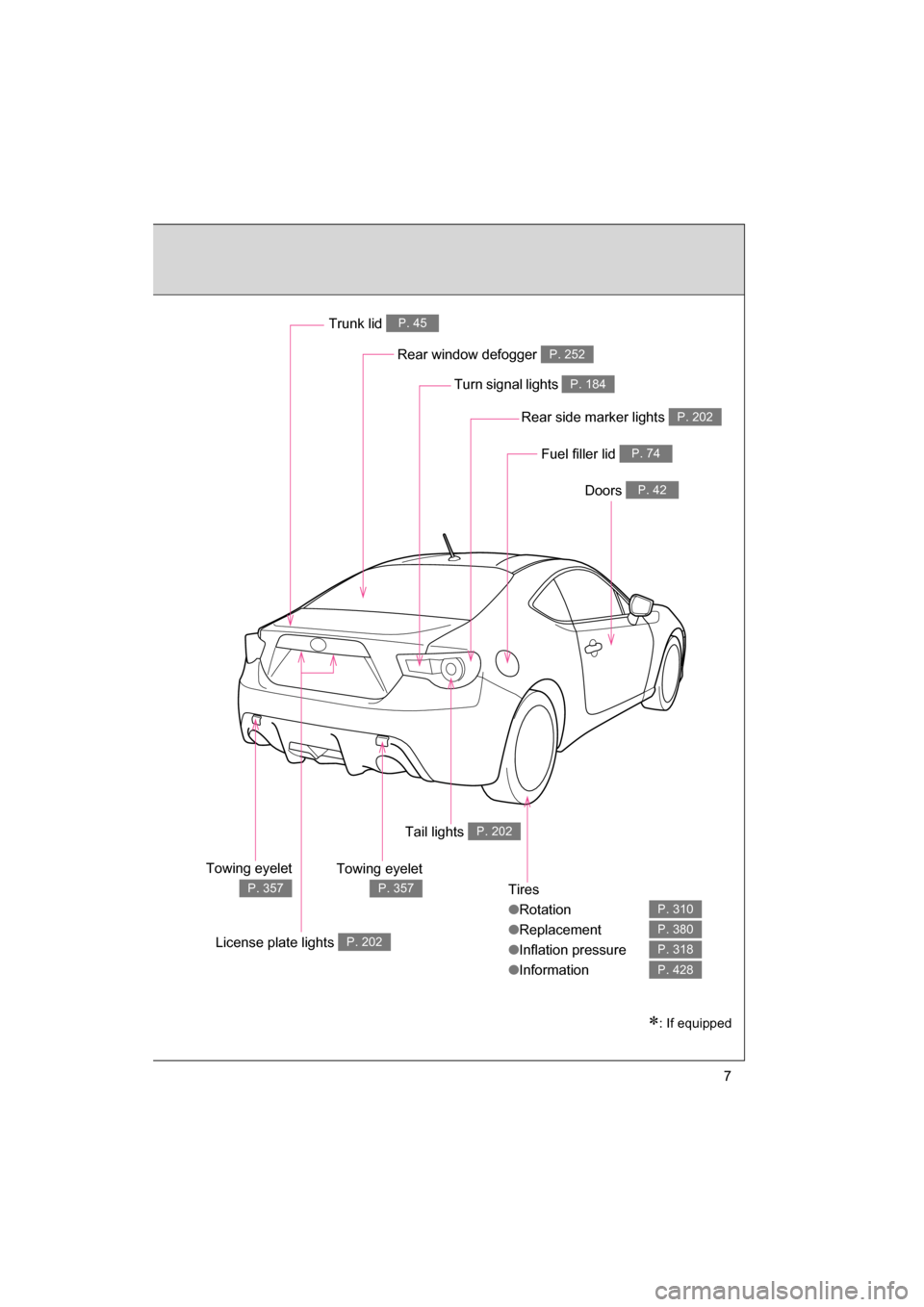
7
Tires
●Rotation
●Replacement
●Inflation pressure
●Information
P. 310
P. 380
P. 318
P. 428
Rear window defogger P. 252
Trunk lid P. 45
Doors P. 42
Fuel filler lid P. 74
Turn signal lights P. 184
Rear side marker lights P. 202
∗: If equipped
License plate lights P. 202
Tail lights P. 202
Towing eyelet
P. 357
Towing eyelet
P. 357
Page 132 of 488
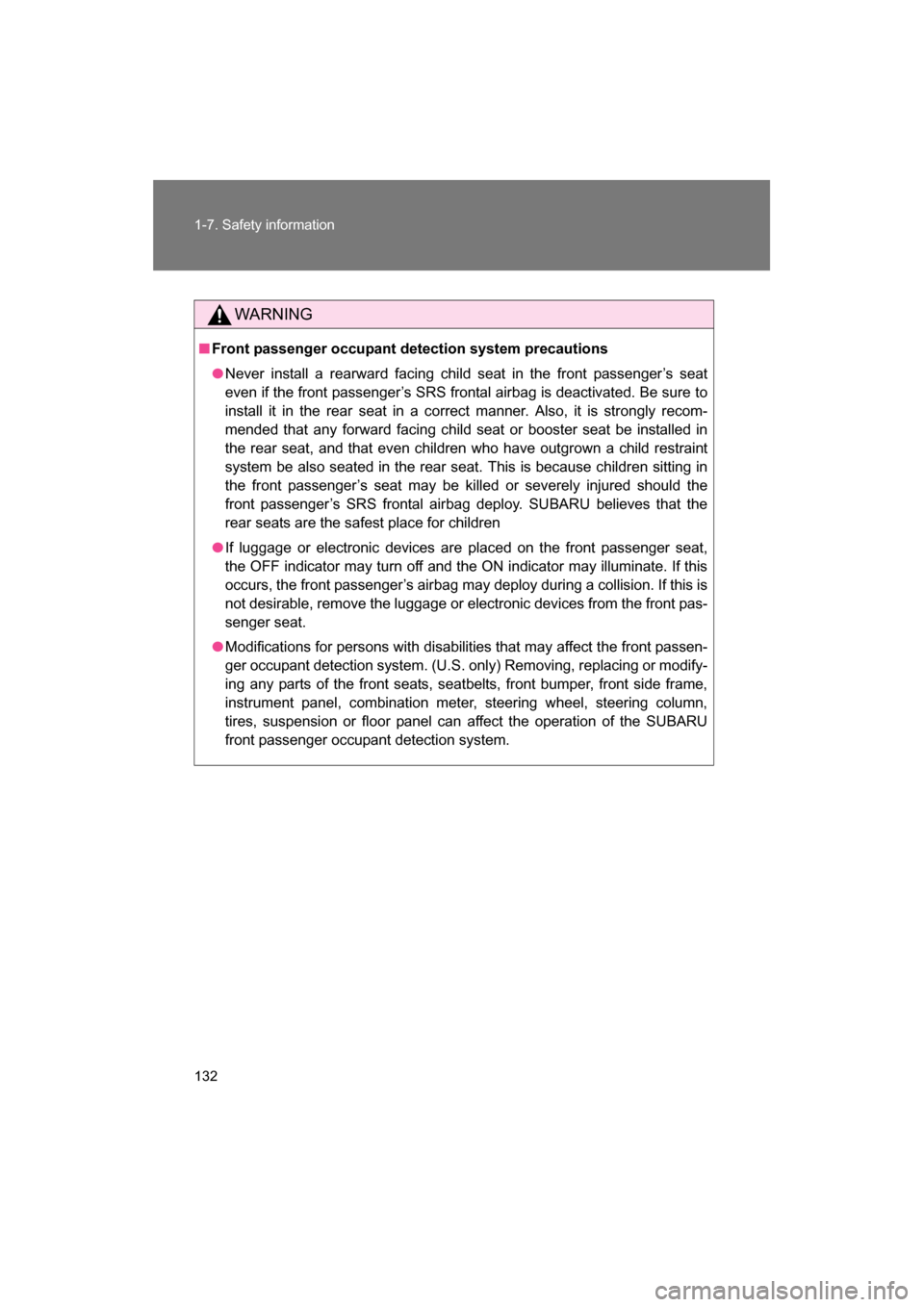
132
1-7. Safety information
WARNING
■Front passenger occupant detection system precautions
●Never install a rearward facing child seat in the front passenger’s seat
even if the front passenger’s SRS frontal airbag is deactivated. Be sure to
install it in the rear seat in a correct manner. Also, it is strongly recom-
mended that any forward facing child seat or booster seat be installed in
the rear seat, and that even children who have outgrown a child restraint
system be also seated in the rear seat. This is because children sitting in
the front passenger’s seat may be killed or severely injured should the
front passenger’s SRS frontal airbag deploy. SUBARU believes that the
rear seats are the safest place for children
●If luggage or electronic devices are placed on the front passenger seat,
the OFF indicator may turn off and the ON indicator may illuminate. If this
occurs, the front passenger’s airbag may deploy during a collision. If this is
not desirable, remove the luggage or electronic devices from the front pas-
senger seat.
●Modifications for persons wi th disabilities that may affect the front passen-
ger occupant detection system. (U.S. onl y) Removing, replacing or modify-
ing any parts of the front seats, seatbelts, front bumper, front side frame,
instrument panel, combination meter, steering wheel, steering column,
tires, suspension or floor panel can affect the operation of the SUBARU
front passenger occupant detection system.
Page 150 of 488
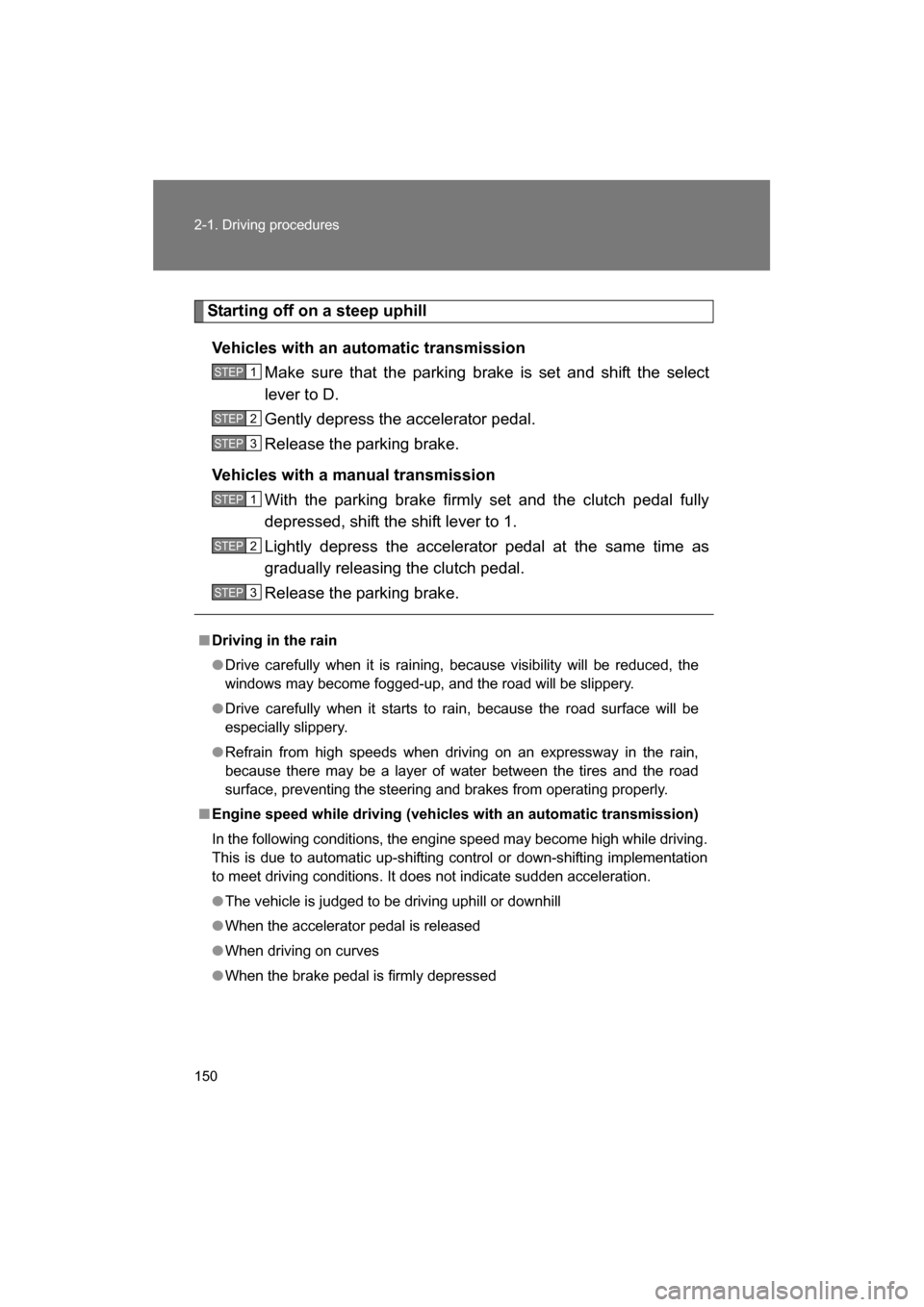
150
2-1. Driving procedures
Starting off on a steep uphillVehicles with an automatic transmission Make sure that the parking brake is set and shift the select
lever to D.
Gently depress the accelerator pedal.
Release the parking brake.
Vehicles with a manual transmission With the parking brake firmly set and the clutch pedal fully
depressed, shift the shift lever to 1.
Lightly depress the accelerator pedal at the same time as
gradually releasing the clutch pedal.
Release the parking brake.
■Driving in the rain
●Drive carefully when it is raining, because visibility will be reduced, the
windows may become fogged-up, and the road will be slippery.
●Drive carefully when it starts to rain, because the road surface will be
especially slippery.
●Refrain from high speeds when driving on an expressway in the rain,
because there may be a layer of water between the tires and the road
surface, preventing the steering and brakes from operating properly.
■Engine speed while driving (vehicl es with an automatic transmission)
In the following conditions, the engine speed may become high while driving.
This is due to automatic up-shifting c ontrol or down-shifting implementation
to meet driving conditions. It does not indicate sudden acceleration.
●The vehicle is judged to be driving uphill or downhill
●When the accelerator pedal is released
●When driving on curves
●When the brake pedal is firmly depressed
STEP 1
STEP 2
STEP 3
STEP 1
STEP 2
STEP 3
Page 155 of 488

155
2-1. Driving procedures
2
When driving
WARNING
●Always check that all passengers' arms, heads or other parts of their body
are not outside the vehicle, as this may result in death or serious injury.
●Do not drive in excess of the speed limit. Even if the legal speed limit per-
mits it, do not drive over 85 mph (140 km/h) unless your vehicle has high-
speed capability tires. Driving over 85 mph (140 km/h) may result in tire
failure, loss of control and possible injury. Be sure to consult a tire dealer
to determine whether the tires on your vehicle are high-speed capability
tires or not before driving at such speeds.
■When driving on slippery road surfaces
●Sudden braking, acceleration and steering may cause tire slippage and
reduce your ability to control the vehicle, resulting in an accident.
●Sudden acceleration, engine braking due to shift changing, or changes in
engine speed could cause the vehicle to skid, resulting in an accident.
●After driving through a puddle, lightly depress the brake pedal to make
sure that the brakes are functioning properly. Wet brake pads may prevent
the brakes from functioning properly. If the brakes on only one side are wet
and not functioning properly, steering control may be affected, resulting in
an accident.
■When shifting the select lever or shift lever
●On vehicles with an automatic transmission, be careful not to shift the
select lever with the accelerator pedal depressed. Shifting the select lever
to a gear other than P or N may lead to unexpected rapid acceleration of
the vehicle that may cause an accident and result in death or serious
injury.
●Do not place items in the select lever’s or shift lever’s surrounding area. It
may cause incorrect operation.
●If the select lever’s or shift lever’s boot is pulled out during cleaning, return
it to its previous position. If the select lever’s or shift lever’s boot is left
pulled out, the select lever or shift lever may become difficult to operate.
Page 223 of 488
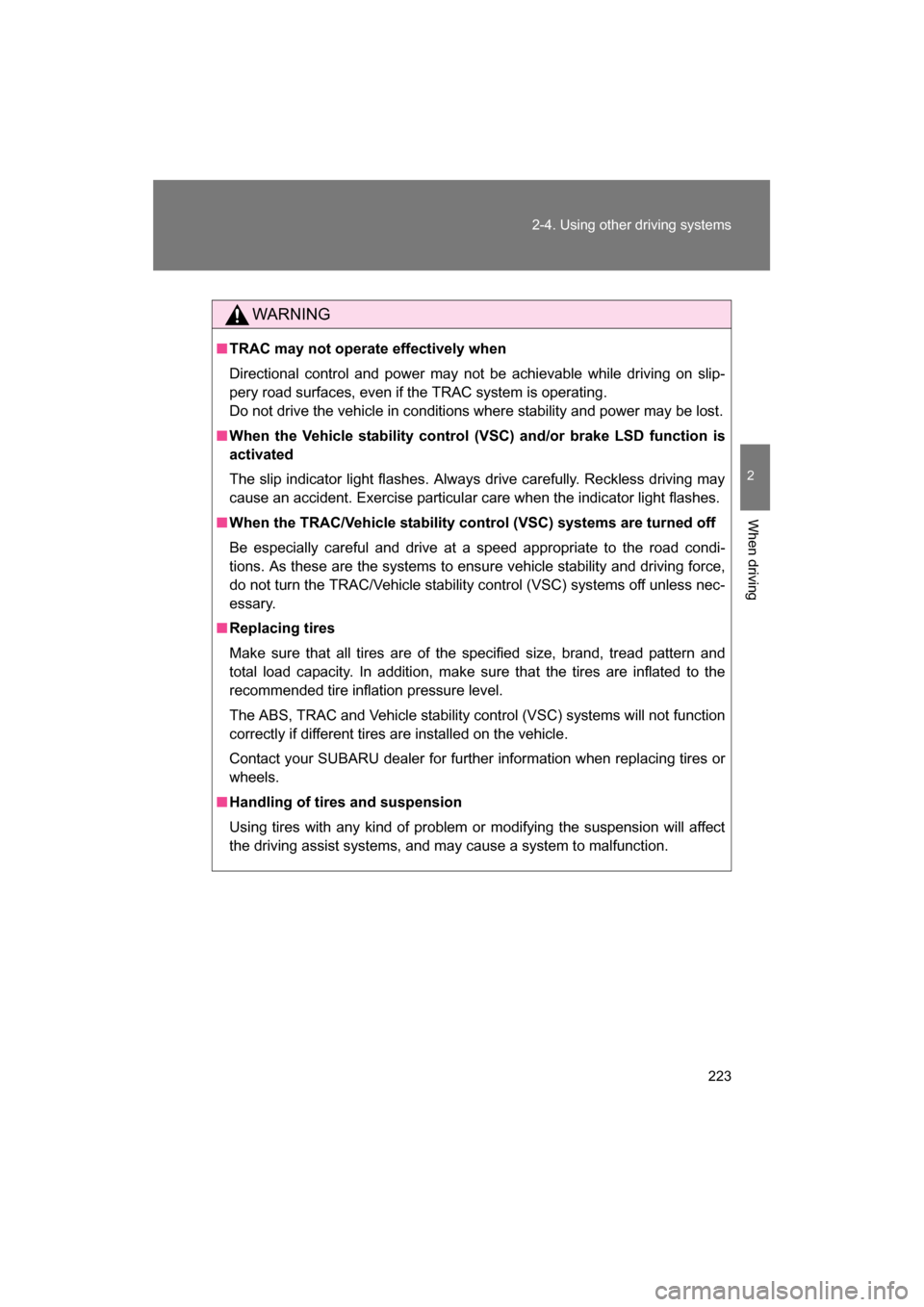
223
2-4. Using other driving systems
2
When driving
WARNING
■TRAC may not operate effectively when
Directional control and power may not be achievable while driving on slip-
pery road surfaces, even if the TRAC system is operating.
Do not drive the vehicle in conditions where stability and power may be lost.
■When the Vehicle stability control (VSC) and/or brake LSD function is
activated
The slip indicator light flashes. Always drive carefully. Reckless driving may
cause an accident. Exercise particular care when the indicator light flashes.
■When the TRAC/Vehicle stability control (VSC) systems are turned off
Be especially careful and drive at a speed appropriate to the road condi-
tions. As these are the systems to ensure vehicle stability and driving force,
do not turn the TRAC/Vehicle stability control (VSC) systems off unless nec-
essary.
■Replacing tires
Make sure that all tires are of the specified size, brand, tread pattern and
total load capacity. In addition, make sure that the tires are inflated to the
recommended tire inflation pressure level.
The ABS, TRAC and Vehicle stability cont rol (VSC) systems will not function
correctly if different tires are installed on the vehicle.
Contact your SUBARU dealer for further information when replacing tires or
wheels.
■Handling of tires and suspension
Using tires with any kind of problem or modifying the suspension will affect
the driving assist systems, and may cause a system to malfunction.
Page 228 of 488
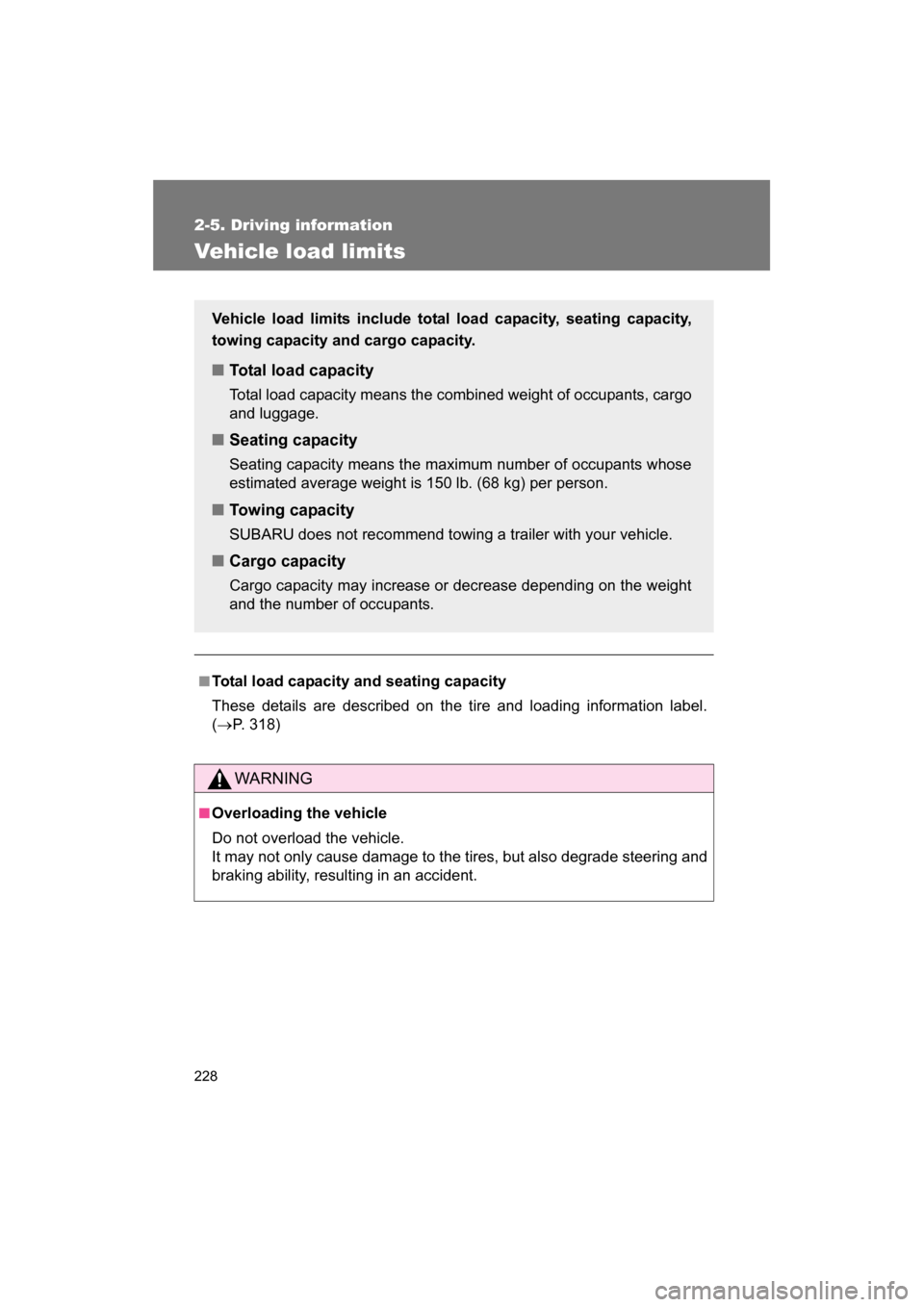
228
2-5. Driving information
Vehicle load limits
■Total load capacity and seating capacity
These details are described on the tire and loading information label. (→ P. 318)
WARNING
■Overloading the vehicle
Do not overload the vehicle.
It may not only cause damage to the tires, but also degrade steering and
braking ability, resulting in an accident.
Vehicle load limits include total load capacity, seating capacity,
towing capacity and cargo capacity.
■Total load capacity
Total load capacity means the combined weight of occupants, cargo
and luggage.
■Seating capacity
Seating capacity means the maximum number of occupants whose
estimated average weight is 150 lb. (68 kg) per person.
■Towing capacity
SUBARU does not recommend towing a trailer with your vehicle.
■Cargo capacity
Cargo capacity may increase or decrease depending on the weight
and the number of occupants.
Page 230 of 488
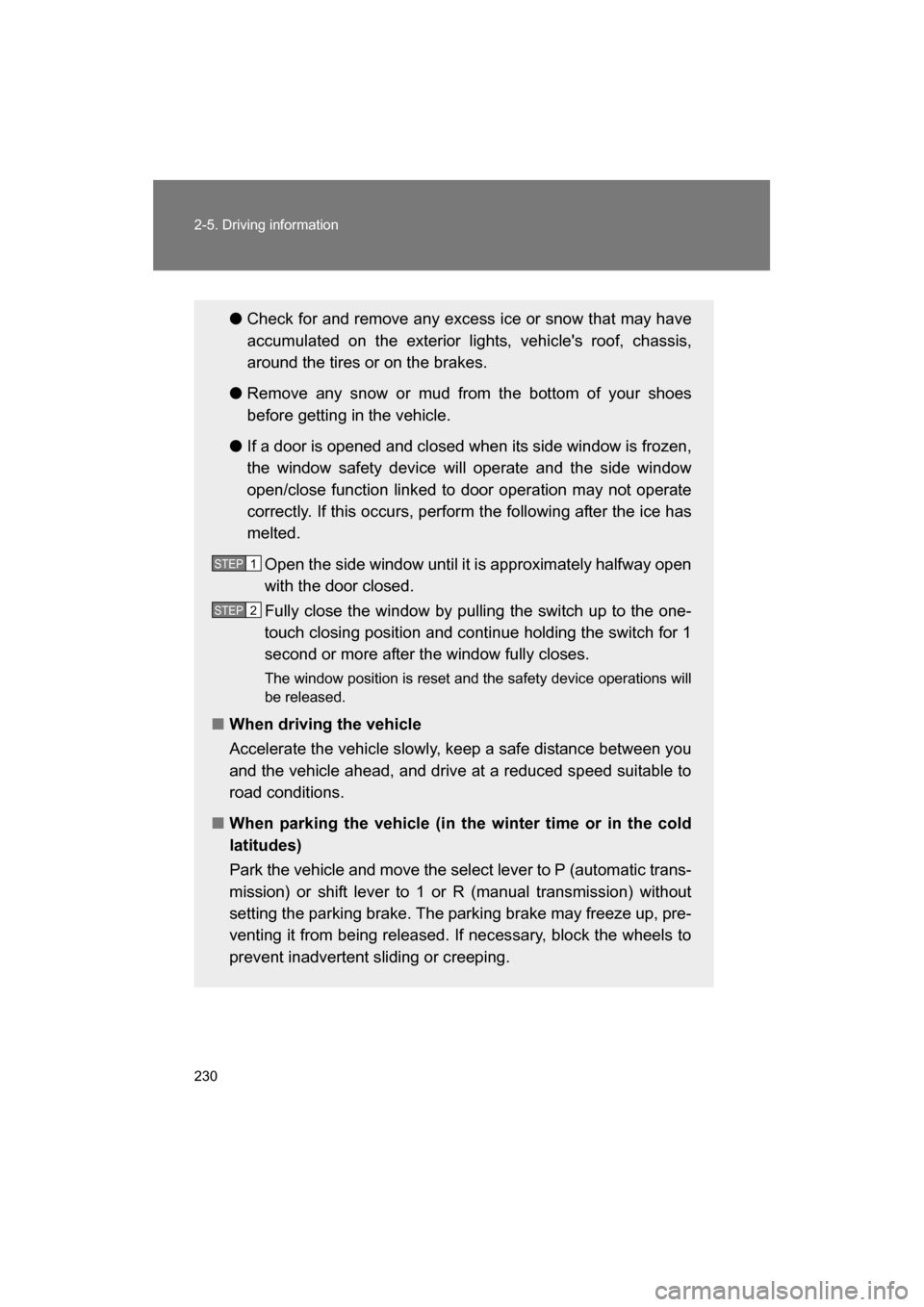
230
2-5. Driving information
●Check for and remove any excess ice or snow that may have
accumulated on the exterior lights, vehicle's roof, chassis,
around the tires or on the brakes.
● Remove any snow or mud from the bottom of your shoes
before getting in the vehicle.
● If a door is opened and closed when its side window is frozen,
the window safety device will operate and the side window
open/close function linked to door operation may not operate
correctly. If this occurs, perform the following after the ice has
melted.
Open the side window until it is approximately halfway open
with the door closed.
Fully close the window by pulling the switch up to the one-
touch closing position and continue holding the switch for 1
second or more after the window fully closes.
The window position is reset and the safety device operations will
be released.
■When driving the vehicle
Accelerate the vehicle slowly, keep a safe distance between you
and the vehicle ahead, and drive at a reduced speed suitable to
road conditions.
■When parking the vehicle (in the winter time or in the cold
latitudes)
Park the vehicle and move the select lever to P (automatic trans-
mission) or shift lever to 1 or R (manual transmission) without
setting the parking brake. The parking brake may freeze up, pre-
venting it from being released. If necessary, block the wheels to
prevent inadvertent sliding or creeping.
STEP 1
STEP 2